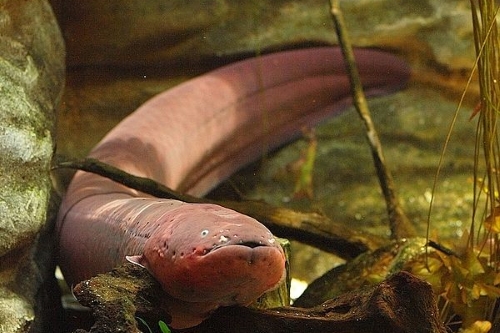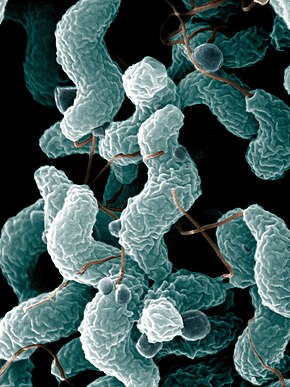Shock Value: Electrifying Hunting Techniques of Electric Eels
 |
| Electrophorus electricus |
Electric eels don’t look like fierce hunters. They have tiny eyes, skinny bodies, and dopey-looking expressions. However, don’t be
fooled. These fish(they
aren’t really eels), pack enough electric force to incapacitate their prey and
send much larger animals jerking hastily away.
The electric eel uses three specialised organs to produce
electricity: Sach’s organ, the main electric organ, and Hunt’s organ. These take up the vast majority of the eel’s
body 1. The main electric
organ produces the most of the fish’s strong electric charge, giving it the
ability to stun prey and defend itself from predators. Sach’s Organ generates continual low electric
currents round the fish, which allows it to sense surrounding objects based on
how they interact with the field 2. Hunt’s organ is somewhat more mysterious, and is believed to help both other organs hunting and navigation 2. These structures, along with pressure-sensing hairs along the fish's body, allow E. electricus to
hunt in the muddy river bottoms they calls home.
To generate electricity, the eel has developed stacks of
specialized cells called electrocytes3. One one side of the electrocyte is ruffled
and rich in a protein pump called the sodium-potassium ATPase. This constantly pumps three positively
charged sodium ions out of the cell and pumps two positively charged potassium
in, giving the interior of the cell a negative charge versus the outside of the
cell. When the nerves connecting the
opposite side of the cell fire, they release a compound called
acetylcholine. Acetylcholine binds
another ion channel on the electrocytes, which opens and allows large amounts
of sodium to rush in and small amounts of potassium to rush out. In this stimulated state, one side of the cell
is negative and the other is positive.
The charge difference within the cell generates an eel’s electric
power.
Figure 3: Electrocytes at rest(L) and stimulated(R). In the resting state, Na+/K+-ATPase maintains a net negative charge inside the cell. When neurons secrete acetylcholine into the space between nerves and electrocytes, channels in the plasma membrane open on one side of the cell and allow large amounts of sodium to rush in. This gives that side of the cell a positive charge.
 |
Figure 4:When a large number of electrocytes are lined up and charged, their combined positive and negative charges generate a stronger voltage.
|
E. electricus uses it's electric organs in a unique hunting method. When an electric eel senses
movement nearby it will first generate two brief electrical shocks4. The shocks cause nearby fish or other creatures’ muscles to twitch. Then,
alerted to its target's location, the eel will grab its prey. With the surprised creature held in its jaws,
it curls into a circle and pins the prey between its head and tail. Its prey is trapped there in the strongest
part of the field, as the eel generates shock after shock in quick
succession. The prey’s muscles are
quickly overstimulated and fatigued by the electric shocks. While the prey is in this stunned state E. electricus wolfs down its meal4.
Video 1: In the video above, the shocks an electric eel generates while hunting is shown by flashing red light.
Adult electric eels can not only produce a powerful dose of
electricity, they can control the amount of electricity they discharge5. This allows them to save energy if they’re
hunting a small crab versus defending themselves from a large fish or
bird. Although they primarily have been
observed shocking other creatures in the water, electric eels have also been
observed jumping out of the water to shock alligators, horses, and humans. One scientist confirmed this behavior by
allowing electric eels to repeatedly shock his arm, while he measured the
voltage of their attacks. This jumping is thought to increase the power of the eel’s attack, as the voltage is more concentrated if it isn't dissipated by surrounding water 5.
Video 2: Kenneth Catania letting an electric eel electric eel shock his arm for science.
Studying electric eels is nothing new. Darwin inspected electric eels on his journey
on the Beagle, Michael Faraday used them in his experiments of electricity 6,
and their electric organs were crucial in examining the structure of the muscle
signalling compound acetylcholine7.
Now engineers are looking to electric eels for inspiration for new
compact batteries that could worn or be used safely in medical devices 8. Electric eels are thriving despite some loss
of habitat, so we can hope that we’ll continue to learn from their stunning electric adaptations for generations to
come.
 |
| Electric Eels: adorably derpy, fierce, and useful |
References:
1.
Gotter,
A.L., Kaetzel, M.A. and Dedman, J.R., 1998. Electrophorus electricus as a model
system for the study of membrane excitability. Comparative Biochemistry and Physiology Part A: Molecular &
Integrative Physiology, 119(1),
pp.225-241.
2.
Sillar,
K.T., Picton, L.D. and Heitler, W.J., Electrolocation and Electric Organs. The Neuroethology of Predation and Escape,
pp.140-177.
3.
Machado,
R.D., de Souza, W., Cotta-Pereira, G. and de Oliveira Castro, G., 1976. On the
fine structure of the electrocyte of Electrophorus electricus L. Cell and tissue research, 174(3), pp.355-366.
4.
Catania,
K.C., 2015. Electric eels concentrate their electric field to induce
involuntary fatigue in struggling prey. Current
Biology, 25(22), pp.2889-2898.
5.
Catania,
K.C., 2017. Power Transfer to a Human during an Electric Eel’s Shocking Leap. Current Biology, 27(18), pp.2887-2891.
6.
Faraday,
M. "Experimental researches in electricity". 1832. Philos. T. R. Soc. Lond. 122, pp125–162
7.
Klett,
R.P., Fulpius, B.W., Cooper, D., Smith, M., Reich, E. and Possani, L.D., 1973.
The acetylcholine receptor I. Purification and characterization of a
macromolecule isolated from Electrophorus electricus. Journal of Biological Chemistry, 248(19), pp.6841-6853.
8.
Schroeder,
T.B., Guha, A., Lamoureux, A., VanRenterghem, G., Sept, D., Shtein, M., Yang,
J. and Mayer, M., 2017. An electric-eel-inspired soft power source from stacked
hydrogels. Nature, 552(7684), p.214.
Images:
Fig5, Video 1:Catania, K.C., 2015. Electric eels concentrate their electric field to induce involuntary fatigue in struggling prey. Current Biology, 25(22), pp.2889-2898.
Video 2: https://www.youtube.com/watch?v=uqlS-B6fM7k





























